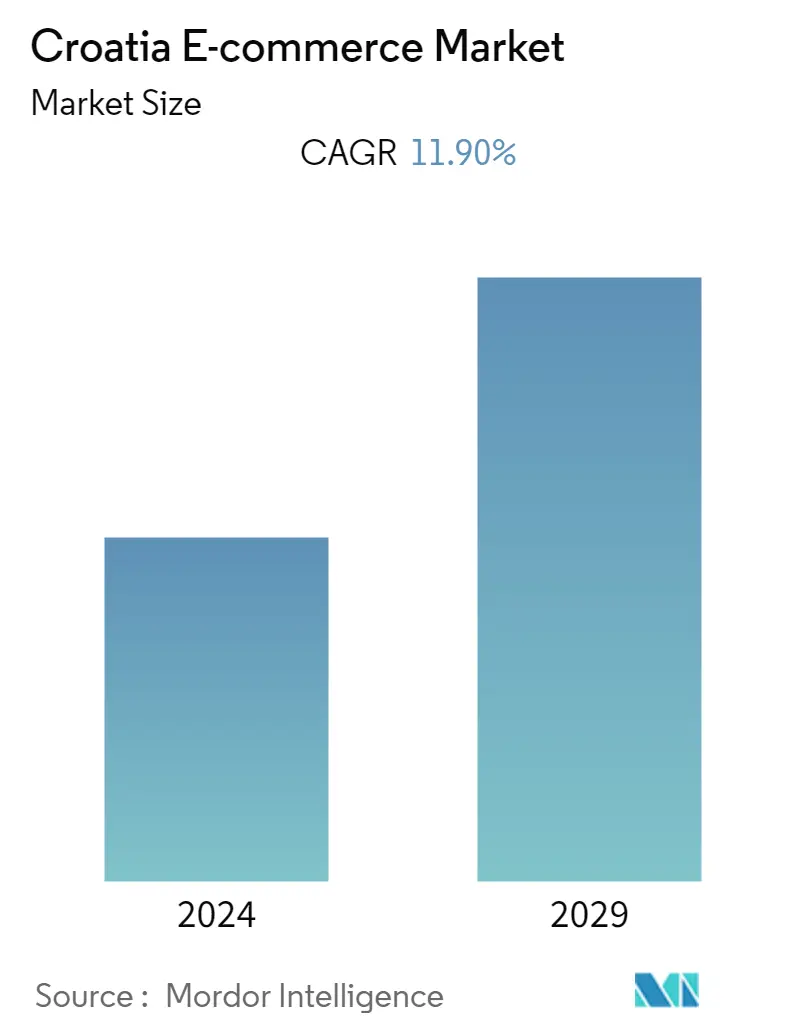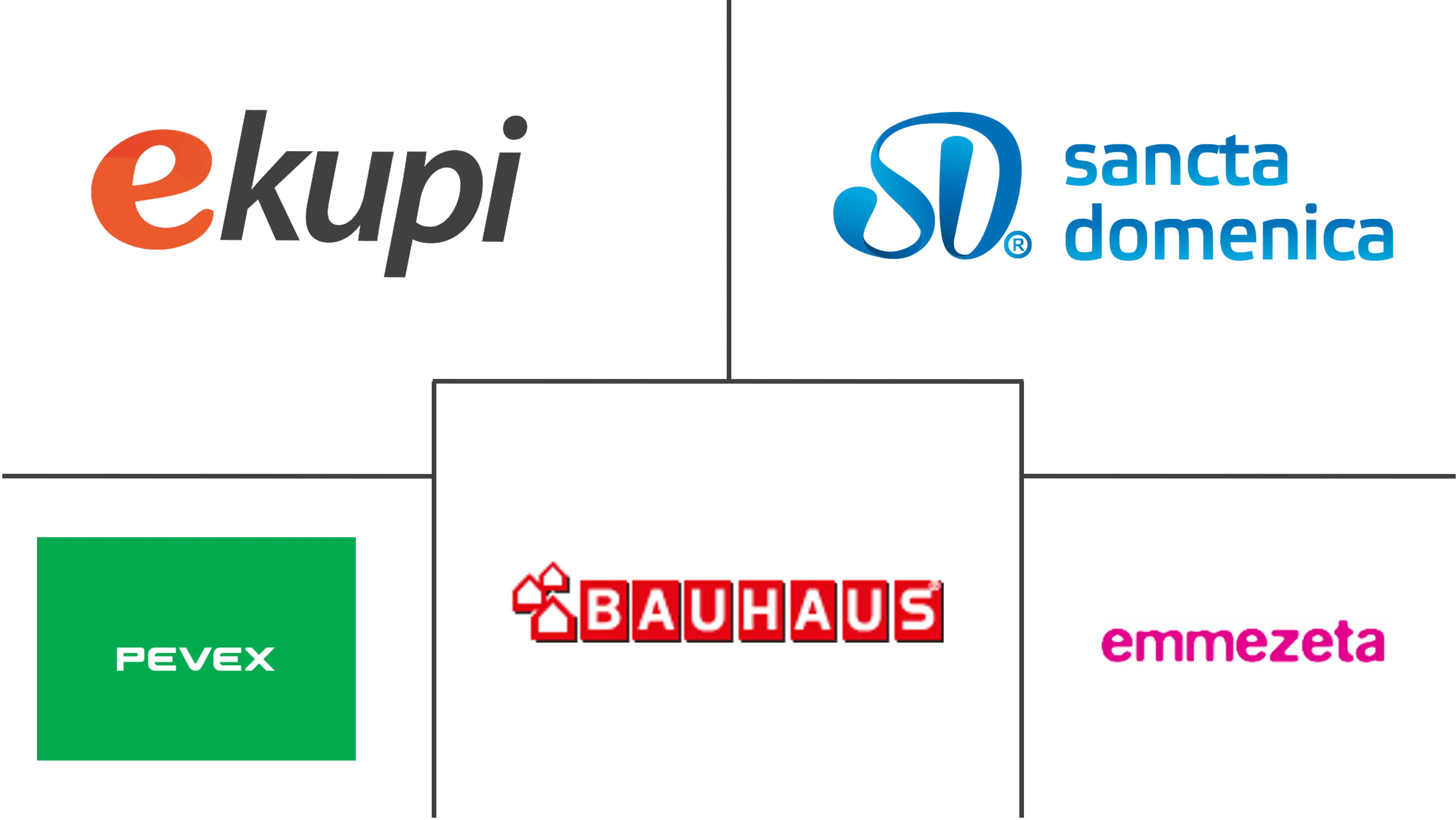Market Size of Croatia E-commerce Industry

| Study Period | 2019 - 2029 |
| Base Year For Estimation | 2023 |
| Forecast Data Period | 2024 - 2029 |
| Historical Data Period | 2019 - 2022 |
| CAGR | 11.90 % |
| Market Concentration | High |
Major Players
*Disclaimer: Major Players sorted in no particular order |
Croatia E-commerce Market Analysis
The Croatia E-commerce market is expected to grow at a CAGR of 11.9% over the forecast period from 2022 to 2027. The European E-Commerce market has been recording robust growth over the last few years, thereby offering exciting opportunities for online retailers across various sectors. However, Croatia is still considered to be maturing market for e-commerce with hopes of higher penetration rates over the forecasted period.
- Croatian e-commerce has grown since the country joined the EU in 2013. Because businesses have already created e-commerce platforms and users are now comfortable with the notion, the COVID-19 pandemic is expected to push increased use of E-commerce.
- According to the International Trade Administration, a significant share of Croatian internet buyers buy from stores located outside of the country, primarily in China and the EU. Media and electronics is the market's largest segment, with a market value of USD 208.0 million in 2020. Clothing, shoes, fashion accessories, and food are all available for purchase online. About 40% of Croatian online shops cater solely to the Croatian market, while the remaining 40% cater to international customers.
- Moreover, the country is witnessing a constant rise in E-commerce sales. New markets are forming, and established markets have the potential for growth even more. Over the next few years, global growth is expected to continue, with Croatia contributing and aiding the same.
- With the introduction of the EU Digital Single Market Strategy, Croatia people will have complete access to all goods and services offered online by EU enterprises. Payments, customer rights, and privacy policies are all covered under the Strategy. According to the Digital Economy and Society Index (DESI) report for 2021, the country ranked 19th of 27 EU Member States. Online shopping is heavily promoted in the media, which is expected to drive the growth of the market in the country.
Croatia E-commerce Industry Segmentation
Conducting an e-commerce business means fostering relationships and selling information, services, and goods over computer communication networks. E-commerce usually refers to trading goods and services over the internet, which means broader economic activity. E-commerce consists of B2B and B2C and internal organizational transactions that support these activities.
The study also tracks the key market parameters, underlying growth influencers, and major vendors operating in the industry, which supports the market estimations and growth rates over the forecast period in Croatia. The study further analyzes the overall impact of COVID-19 on the ecosystem. The scope of the report encompasses market sizing and forecast for segmentation by B2B and B2C, in which the B2C channel is further segmented by application.
| By B2C E-Commerce | ||||||||
| Market size (GMV) for the period of 2017-2027 | ||||||||
|
| By B2B E-Commerce | |
| Market size for the period of 2017-2027 |
Croatia E-commerce Market Size Summary
The Croatian e-commerce market is experiencing a phase of significant growth, driven by the increasing adoption of online shopping and the expansion of digital platforms. Since joining the European Union, Croatia has seen a steady rise in e-commerce activities, with the COVID-19 pandemic further accelerating this trend. The market is characterized by a diverse range of products available online, including media, electronics, clothing, and food. While a substantial portion of online purchases is made from international retailers, there is a growing number of domestic platforms catering to local consumers. The introduction of the EU Digital Single Market Strategy is expected to enhance access to online goods and services, further boosting the market's expansion.
The rise of mobile commerce and the widespread use of smartphones have significantly influenced the Croatian e-commerce landscape. Social media platforms like Facebook, Instagram, and YouTube have become crucial marketing channels, facilitating product promotion and consumer engagement. International e-commerce giants such as Amazon, eBay, and AliExpress are popular among Croatian consumers, alongside local platforms like eKupi and Emmezeta. The market is also witnessing the emergence of new players and the expansion of existing ones, with companies like ASOS and Zalando recently entering the Croatian market. This dynamic environment is expected to continue fostering growth, with both domestic and international retailers playing a pivotal role in shaping the future of e-commerce in Croatia.
Croatia E-commerce Market Size - Table of Contents
-
1. MARKET INSIGHTS
-
1.1 Market Overview
-
1.2 Industry Attractiveness-Porter's Five Forces Analysis
-
1.2.1 Bargaining Power of Suppliers
-
1.2.2 Bargaining Power of Buyers/Consumers
-
1.2.3 Threat of New Entrants
-
1.2.4 Threat of Substitute Products
-
1.2.5 Intensity of Competitive Rivalry
-
-
1.3 Key market trends and share of E-Commerce of Total Retail sector
-
1.4 Impact of COVID-19 on the E-Commerce sales
-
-
2. MARKET SEGMENTATION
-
2.1 By B2C E-Commerce
-
2.1.1 Market size (GMV) for the period of 2017-2027
-
2.1.2 Market Segmentation - By Application
-
2.1.2.1 Beauty & Personal Care
-
2.1.2.2 Consumer Electronics
-
2.1.2.3 Fashion & Apparel
-
2.1.2.4 Food & Beverage
-
2.1.2.5 Furniture & Home
-
2.1.2.6 Others (Toys, DIY, Media, etc.)
-
-
-
2.2 By B2B E-Commerce
-
2.2.1 Market size for the period of 2017-2027
-
-
Croatia E-commerce Market Size FAQs
What is the current Croatia E-commerce Market size?
The Croatia E-commerce Market is projected to register a CAGR of 11.90% during the forecast period (2024-2029)
Who are the key players in Croatia E-commerce Market?
Ekupi d.o.o, Bauhaus.hr, Pevex.hr, Sancta Domenica d.o.o. and Fliba d.o.o. are the major companies operating in the Croatia E-commerce Market.

